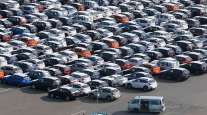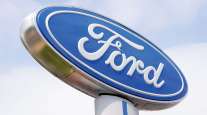China's Bold Gambit to Cement Trade With Europe — Along the Ancient Silk Road
From his office on a bend of the Rhine River, freight terminal boss Bernd Putens can see — and hear — the early stirrings of what China calls the New Silk Road.
The clang-clang of forklifts echoes through his building as 42 containers of cargo are unloaded at the Duisburg Intermodal Terminal, part of the world's largest inland port.
The containers have just arrived on a train from Changsha, China, filled with electronics and other consumer goods, and will return carrying Land Rovers and other European products.
They represent a bold effort by Chinese leader Xi Jinping to extend his country's economic and political clout.
Until four years ago, there was no regular rail service linking China and Germany, and for good reason.
The tracks existed, but at nearly 7,000 miles, the distance is longer than a round trip between Los Angeles and Boston, and trains must switch gauges — a laborious, time-consuming process — as they pass from China into Kazakhstan, Russia, Belarus and Poland. Trains are twice as fast as sea shipment yet twice as expensive, so rail makes sense only for high-value products or goods with short shelf lives.
But two millenniums after traders began ferrying gems, precious metals, fabrics and spices on arduous overland routes linking the Far East with Africa, the Mediterranean and the Middle East, China believes the time is nigh for a modern Silk Road. Leaders in Beijing envision a 21st-century version of the path trod by the likes of Marco Polo, starting with locomotives but quickly expanding to encompass roads, pipelines and other infrastructure.
By physically linking itself more tightly with Europe, the Middle East and Central Asia, China is aiming to create new markets as growth slows at home while deepening Beijing's influence across Asia and as far away as the Middle East and Europe.
The effort is at the center of Xi's signature political and economic policy initiative, called the Silk Road Economic Belt and 21st Century Maritime Silk Road.
For two years, Xi has been talking up the sweeping strategy — known collectively as One Belt, One Road, or OBOR — on his frequent trips abroad, while lining up financing plans at home and enlisting the participation of state-run and private companies.
With its expansive ambition, some observers have compared China's grand new endeavor to America's Marshall Plan to rebuild Europe after World War II, a game-changing effort that revolutionized trade and recast many long-standing relationships.
It is expected to cost even more than the Marshall Plan, for which the United States spent the equivalent of slightly more than $100 billion in today's money.
"With these initiatives, Beijing, and more particularly, the Chinese Communist Party, seeks to reinforce the emerging global narrative that China is moving to the center of global economic activity, strength and influence," Christopher K. Johnson of the Washington-based Center for Strategic and International Studies said in a recent paper analyzing One Belt, One Road.
Markus Taube, a professor of East Asian economic studies at the University of Duisburg-Essen, believes the initiative "will strengthen China's economic and diplomatic leverage in Europe and provide a political and diplomatic counterweight against the U.S."
"The more I think about [the strategy], the more it makes sense," he said.
But others are more skeptical, saying China's lofty language around One Belt, One Road masks myriad questions about how much money will be spent on the project and where, and who will benefit.
"It's generated a lot of buzz, but no one is quite sure what it actually means," said Ian Storey, a senior fellow at the Institute of Southeast Asian Studies in Singapore.
China's government has set up a $40 billion fund to promote private investment in One Belt, One Road initiatives and is encouraging state-run banks to make loans for projects including power plants, ports, pipelines and railways — to be built overseas, in many cases, by Chinese companies. The Bank of China has announced plans to fund $120 billion of those projects from 2015 to 2019.
In January, the China-led Asian Infrastructure Investment Bank officially opened its doors, and the multinational institution is expected to finance tens of billions of dollars' worth of projects that fall under the One Belt, One Road umbrella.
Chinese firms, eager to avail themselves of government financial incentives and align themselves with a key Communist Party priority, are scrambling to get on board and show they're embracing One Belt, One Road.
Although massive ground-up infrastructure projects will take years to come to fruition, the ripple effects of the strategy are being felt in places such as Duisburg.
Xi visited the German city in 2014 to tout the rail project, and since then, interest in China-to-Germany freight has surged. Now Duisburg is receiving one train every day from China, including three to five a week from Chongqing, two a week from Wuhan and one a week from Changsha. There also are weekly trains to Hamburg from Wuhan and Zhengzhou.
"Now it seems every [Chinese] city wants to send its own train," Putens said.




